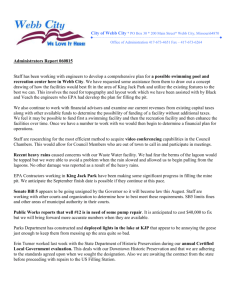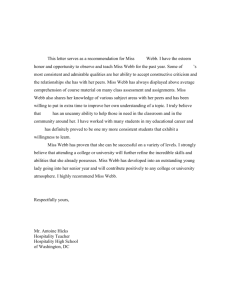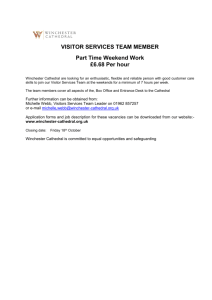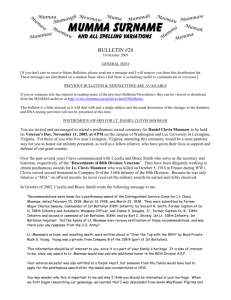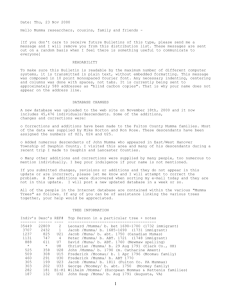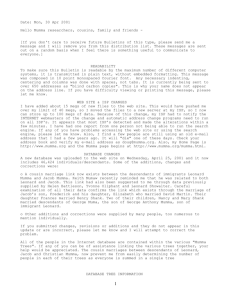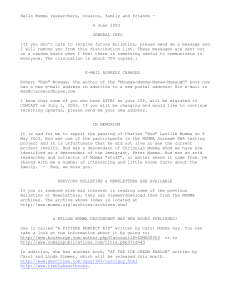Who fathered William F
advertisement
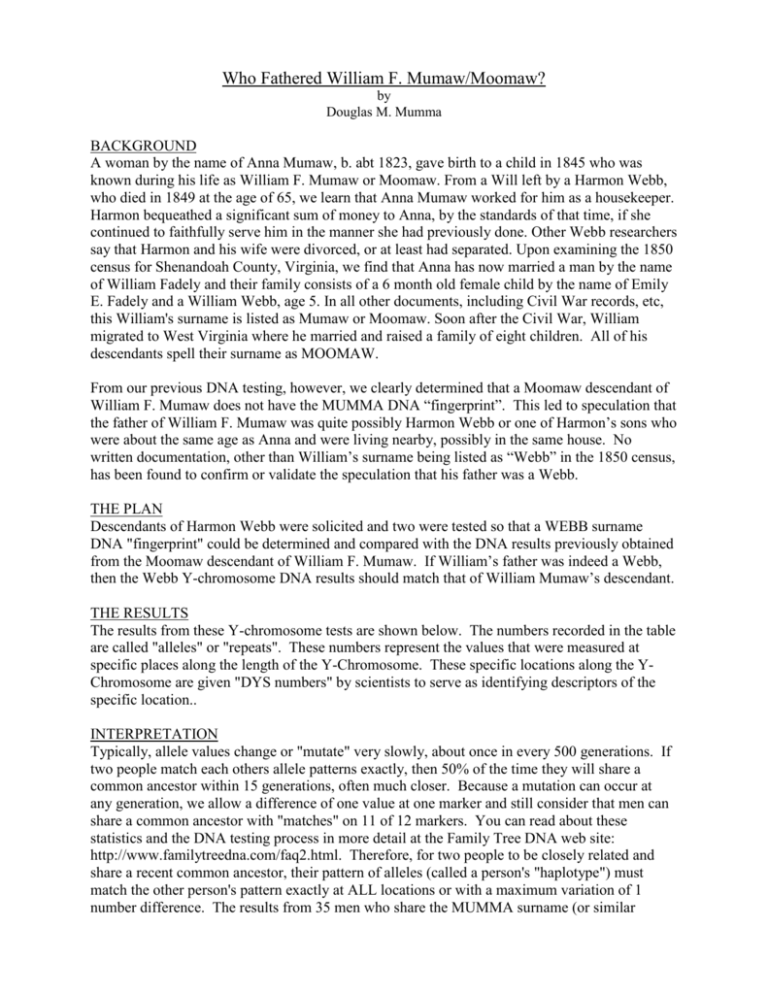
Who Fathered William F. Mumaw/Moomaw? by Douglas M. Mumma BACKGROUND A woman by the name of Anna Mumaw, b. abt 1823, gave birth to a child in 1845 who was known during his life as William F. Mumaw or Moomaw. From a Will left by a Harmon Webb, who died in 1849 at the age of 65, we learn that Anna Mumaw worked for him as a housekeeper. Harmon bequeathed a significant sum of money to Anna, by the standards of that time, if she continued to faithfully serve him in the manner she had previously done. Other Webb researchers say that Harmon and his wife were divorced, or at least had separated. Upon examining the 1850 census for Shenandoah County, Virginia, we find that Anna has now married a man by the name of William Fadely and their family consists of a 6 month old female child by the name of Emily E. Fadely and a William Webb, age 5. In all other documents, including Civil War records, etc, this William's surname is listed as Mumaw or Moomaw. Soon after the Civil War, William migrated to West Virginia where he married and raised a family of eight children. All of his descendants spell their surname as MOOMAW. From our previous DNA testing, however, we clearly determined that a Moomaw descendant of William F. Mumaw does not have the MUMMA DNA “fingerprint”. This led to speculation that the father of William F. Mumaw was quite possibly Harmon Webb or one of Harmon’s sons who were about the same age as Anna and were living nearby, possibly in the same house. No written documentation, other than William’s surname being listed as “Webb” in the 1850 census, has been found to confirm or validate the speculation that his father was a Webb. THE PLAN Descendants of Harmon Webb were solicited and two were tested so that a WEBB surname DNA "fingerprint" could be determined and compared with the DNA results previously obtained from the Moomaw descendant of William F. Mumaw. If William’s father was indeed a Webb, then the Webb Y-chromosome DNA results should match that of William Mumaw’s descendant. THE RESULTS The results from these Y-chromosome tests are shown below. The numbers recorded in the table are called "alleles" or "repeats". These numbers represent the values that were measured at specific places along the length of the Y-Chromosome. These specific locations along the YChromosome are given "DYS numbers" by scientists to serve as identifying descriptors of the specific location.. INTERPRETATION Typically, allele values change or "mutate" very slowly, about once in every 500 generations. If two people match each others allele patterns exactly, then 50% of the time they will share a common ancestor within 15 generations, often much closer. Because a mutation can occur at any generation, we allow a difference of one value at one marker and still consider that men can share a common ancestor with "matches" on 11 of 12 markers. You can read about these statistics and the DNA testing process in more detail at the Family Tree DNA web site: http://www.familytreedna.com/faq2.html. Therefore, for two people to be closely related and share a recent common ancestor, their pattern of alleles (called a person's "haplotype") must match the other person's pattern exactly at ALL locations or with a maximum variation of 1 number difference. The results from 35 men who share the MUMMA surname (or similar spelling variations) have established a MUMMA modal haplotype or “fingerprint” for this surname. We determined that the allele values of 21 of the 35 men matched each other exactly at all 12 markers and those values are defined to be the Mumma Modal Haplotype. In addition, 32 men matched each other with only a difference of one number and all are clearly related. ANALYSIS and CONCLUSIONS This criteria was then used to examine the Webb results. The MUMMA haplotype is shown on the first line of the table and those of William F. Mumaw’s descendant are on the second line. Comparing their allele values shows that there were matches on only 3 of the first 12 markers and 4 matches when examining all 21 markers. This man clearly does not share a common male MUMMA surname ancestor The results from the two WEBB men show that they matched each other exactly and they matched the values recorded for the MOOMAW participant for his first 12 markers. This proves that the two WEBB participants and the MOOMAW descendant of William Mumaw share a close common ancestor. Further, the Y-chromosome haplotype determined for this WEBB family does not closely match the MUMMA haplotype and we can conclude the two surnames do not share a common male ancestor in the recent past. From these results we have determined that William F. Mumaw was fathered by a man with the WEBB surname haplotype, but we cannot say for certain that it was Harmon Webb. It is known that at least one of Harmon Webb’s sons was single in 1840, living nearby or in the household and he also could have been the father. He was about the same age as Anna Mumaw. This small project clearly demonstrates the power of DNA testing to help prove paternity issues where clear documentation is lacking. In addition, the descendants of Harmon Webb now have "newly found" Moomaw cousins and a WEBB haplotype has been identified for this Virginia branch of the WEBB family. 3 3 1 3 3 9 9 9 9 8 3 0 1 5 a Kit# SURNAME DYS # 3 4 3 4 3 3 3 4 4 4 4 4 4 4 4 4 8 2 8 3 8 9 8 5 5 5 5 5 4 3 4 4 5 6 8 9 9 2 9 8 9 9 5 4 7 7 8 9 b | | a b 1 2 Various MUMMA 13 25 14 11 11 14 12 12 13 13 13 29 17 9 10 11 11 24 15 19 30 720 Moomaw 14 22 14 10 13 13 11 14 12 13 11 29 15 8 9 8 11 22 16 20 29 1857 Webb 14 22 14 10 13 13 11 14 12 13 11 29 1858 Webb 14 22 14 10 13 13 11 14 12 13 11 29

